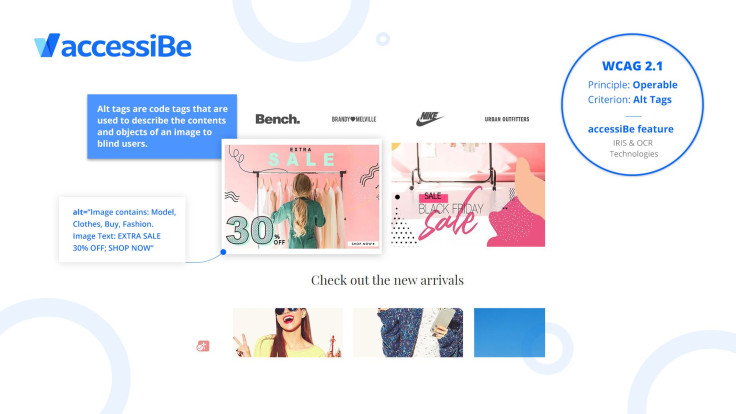3 Compelling Reasons Why Every Company Should Implement Web Accessibility

Take a moment and try to remember the last time that you didn’t use the internet at all for 24 hours consecutively: no email, no news, no shopping. For some of us, the answer could be over a decade ago.
According to Pew Research, our daily lives absolutely revolve around being connected online. Now, consider maintaining your lifestyle with severely limited access to the internet. It’s hard to look beyond our own bubble and to foresee the needs of others, so the fact that people who suffer from disabilities are at a great disadvantage online is often overlooked.
In recent years, there has been greater pressure on businesses and developers to level the playing field online. On this note, it’s important to remember that improving the online experience for this demographic is not a zero-sum game. Here are 3 things that you can do to not only make a user’s life easier, but also protect your business and increase conversion rates.
Allowing access to people with disabilities
People with disabilities can often find themselves feeling disenfranchised and frustrated when on the internet. And when companies look to be more inclusive organizationally, people with disabilities are a critical demographic that should not be ignored.
Core to the mission of the world-wide web is making the internet accessible to individuals of all backgrounds. Of course, that includes those who are visually-, motor-, or cognitively-impaired. In America alone, over 48.9 million people suffer from a disability of some kind; by not accounting for web accessibility, you could be barring a significant portion of the general population from the basic right to access your site properly.
In the past, making a company’s website accessible could take weeks to accomplish, depending on the number of pages a website has, not to mention it would be difficult to account for people with various disabilities. accessiBe, the leading web accessibility tool that leverages machine learning to automate the accessibility process, takes the guesswork and hassle out of what used to be a long-drawn process.
From optimizing websites to be viewed by screen readers with AI-driven alt-text, to simplifying keyboard navigation for those with motor impairments to allowing people with epilepsy to disable website animations at the click of a button, accessiBe makes it simple to make your website easily-accessible for website visitors of all backgrounds.

To date, over 3500 small businesses and industry leaders alike utilize accessiBe’s service to automatically acclimate their websites to remain compliant with accessibility regulations including the ADA, WCAG 2.1 & Section 508 while making them within everyone’s reach.
Compliance prevents ADA lawsuits
By making your website more accessible to people with disabilities, you’re also protecting your company from potentially costly and time-consuming litigation. Although the ADA actually makes no explicit mention of websites, as it was signed into law before the rise of the internet, courts have come to interpret websites as “places of public accommodation.” This means that your website must indeed adhere to this law. You can read through all of the accessibility standards here, courtesy of the Web Accessibility Initiative.
Guidelines are quite rigid, and lawyers are on the hunt for a good case. As ADA compliance is regarded with strict liability, there is zero tolerance for not implementing proper accommodation. So be prepared. Every day that you don’t take action to make your content accessible, you are risking a lawsuit.
And this is far from theoretical. Just in 2014, H&R block was sued by the National Federation of the Blind for its lack of website accessibility. Ultimately, the company paid out $100,000 for the misstep, which doesn’t sound like a huge deal for a multi-billion-dollar public company like H&R block. On the other hand, such a lawsuit could cause a startup to close its doors.
Accessibility can increase conversion rates
Aside from dodging costly litigation and negative digital reputation, establishing website accessibility can even increase your conversion rates. The demographic of people who need accessibility functions to successfully operate online is often underestimated, creating a great potential for profit if proper action is taken.
A 2016 study of UK consumers found that 71% of disabled online customers would leave a website that they struggled to use. This group of users accounts for a not so modest 10% of estimated online spending in the UK, with approximately £11.75 billion in purchasing power. When scaled up to the global level, the purchasing power of consumers with impairments is massive.
Increasing accessibility unlocks this substantial share of the market as potential customers. You’re bound to notice an uptick in conversion rates when every viewer can comfortably navigate your site and has an easy pathway to paying customer status.
Because web accessibility is hardly widespread, the psychological relief for someone to come across a business that caters to their particular needs can go a long way as well. Building a reputation as a company that breaks access barriers to assist customers is a strong investment for your business.
Conclusions
Whether for moral or monetary reasons, there is no reason for companies to ignore web accessibility in 2019 and beyond. Making it easy for people with disabilities to seamlessly access your site while skirting potential litigation sounds like a no-brainer.
And with the advent of technology today, making your website accessible isn’t as grueling a process as it used to be. It doesn’t take weeks to ensure that any video on your site is properly subtitled and that images have proper alt text associated with them anymore. So at this point, there’s no reason you shouldn’t do it.





















